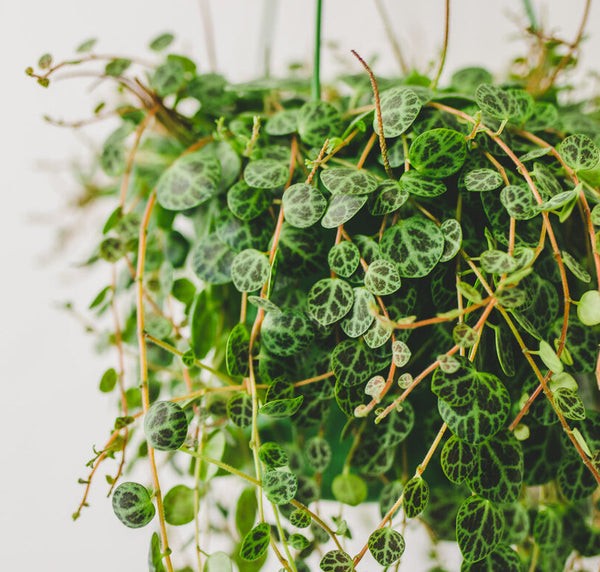Taking proper care of your String of Turtles, also known as Peperomia prostrata, involves understanding its needs for light, watering, and humidity. At CARS.EDU.VN, we offer detailed guides and expert advice to help you cultivate a thriving indoor garden. Discover our resources for plant care and maintenance to ensure your String of Turtles flourishes.
1. Understanding the String of Turtles Plant
The String of Turtles (Peperomia prostrata) is a delightful, semi-succulent plant prized for its unique leaves that resemble tiny turtle shells. Native to the Brazilian rainforests, this plant thrives in warm, humid environments, making it an excellent choice for indoor gardening. Understanding its natural habitat is crucial for providing the best possible care.
1.1. Origins and Natural Habitat
The String of Turtles originates from the tropical rainforests of Brazil, where it grows as an epiphyte, clinging to trees and other surfaces. In its natural environment, it receives filtered sunlight, high humidity, and consistent moisture. Replicating these conditions indoors is essential for its health and vigor.
1.2. Key Characteristics and Appearance
This plant is characterized by its trailing vines adorned with small, round leaves that feature intricate patterns resembling turtle shells. The leaves are typically green with lighter green or silver markings, adding to their ornamental appeal. The vines can grow up to 12 inches long, making it perfect for hanging baskets or displaying on shelves.
1.3. Benefits of Growing String of Turtles
Growing String of Turtles offers several benefits:
- Aesthetic Appeal: Its unique foliage adds visual interest to any indoor space.
- Easy Care: Once established, it is relatively low-maintenance.
- Air Purifying: Like many indoor plants, it helps improve air quality.
- Therapeutic: Caring for plants can be a relaxing and rewarding hobby.
2. Essential Care Requirements
To ensure your String of Turtles thrives, pay close attention to its specific needs regarding potting mix, lighting, watering, temperature, and humidity. Neglecting these factors can lead to common problems such as leaf drop, fading, and root rot.
2.1. Choosing the Right Potting Mix
Selecting the appropriate potting mix is crucial for the health of your String of Turtles. A well-draining mix prevents waterlogging, which can lead to root rot.
- Free-Draining Mix: Essential for preventing root rot.
- Soil-Free Mix: Preferred as it retains less water than soil-based mixes.
- Fine-Grade Mix: Ideal for the plant’s shallow, fine roots.
Recommended Potting Mix Recipe:
| Ingredient | Proportion | Benefit |
|---|---|---|
| Succulent/Cactus Mix | 2 Parts | Provides essential nutrients and drainage. |
| Plant Pumice | 1 Part | Enhances drainage and aeration, preventing soil compaction. |


DIY Potting Mix Option:
| Ingredient | Proportion | Benefit |
|---|---|---|
| Fine-Grade Orchid Bark | 1 Part | Provides excellent drainage and aeration. |
| Peat Moss | 1 Part | Retains moisture while allowing for good airflow. |
| Fern Fibre | 1/2 Part | Adds structure and helps retain moisture. |
| Plant Pumice | 1/2 Part | Enhances drainage and aeration, preventing soil compaction. |
2.2. Optimal Lighting Conditions
String of Turtles thrives in medium to bright indirect light. Direct sunlight can scorch its delicate leaves, while insufficient light can cause fading and stunted growth.
- Indirect Light: Essential for healthy growth and vibrant colors.
- Avoid Direct Sun: Prevents leaf burn and damage.
- Rotate Regularly: Ensures even light exposure for all parts of the plant.
2.3. Watering Techniques for Healthy Growth
Proper watering is critical for maintaining a healthy String of Turtles. Overwatering can lead to root rot, while underwatering can cause leaf drop and dehydration.
- Lightly Moist Soil: Maintain consistent moisture without waterlogging.
- Water When Top Inch is Dry: Use your finger to check soil moisture before watering.
- Bottom Watering: Encourages root growth and prevents wet leaves.
Watering Tips:
- Frequency: Water every 1-2 weeks, depending on environmental conditions.
- Technique: Water thoroughly until excess water drains from the pot.
- Observation: Monitor the plant for signs of over or underwatering.
2.4. Temperature and Humidity Preferences
String of Turtles prefers warm temperatures and high humidity, mimicking its native rainforest habitat.
- Temperature Range: 64-84°F (18-29°C).
- Humidity Levels: Above 40%, ideally 70-80%.
- Avoid Cold Drafts: Protect the plant from sudden temperature changes.
Tips for Maintaining Humidity:
- Humidifier: Use a humidifier to increase ambient humidity.
- Pebble Tray: Place the pot on a tray filled with water and pebbles.
- Grouping Plants: Grouping plants together can create a localized humid environment.
2.5. Fertilizing Your String of Turtles
Fertilizing provides essential nutrients for healthy growth, especially during the growing season.
- Balanced Fertilizer: Use a balanced, water-soluble fertilizer.
- Diluted Strength: Apply fertilizer at half-strength to prevent over-fertilization.
- Frequency: Fertilize every 2-4 weeks during the growing season (spring and summer).
Recommended Fertilizers:
| Fertilizer Type | Benefit | Application |
|---|---|---|
| GT Foliage Focus | Contains calcium for stronger leaves and is low in salts to prevent root burn. | Apply at half-strength every time you water during the growing season. |
| Superthrive Foliage Pro | Urea-free formula that promotes healthy foliage growth. | Apply at half-strength every time you water during the growing season. |
3. Propagating String of Turtles
Propagating String of Turtles is a rewarding way to expand your collection or share this delightful plant with friends. Stem cuttings and leaf propagation are the most common methods.
3.1. Stem Cuttings
Stem cuttings are a reliable method for propagating String of Turtles.
- Select a Healthy Stem: Choose a stem with multiple leaves.
- Cut the Stem: Use clean scissors or pruning shears to cut a 2-3 inch section.
- Remove Lower Leaves: Remove the bottom leaves to expose nodes.
- Rooting Medium: Place the cutting in water or moist sphagnum moss.
- Provide Humidity: Cover with a plastic bag or humidity dome.
- Wait for Roots: Roots typically develop in 2-4 weeks.
- Plant in Soil: Once roots are established, plant in a well-draining potting mix.
3.2. Leaf Propagation
Leaf propagation is another effective method, although it may take longer to produce new plants.
- Select Healthy Leaves: Choose plump, healthy leaves with a small piece of stem attached.
- Callus Formation: Allow the cut end to callus over for a day or two.
- Rooting Medium: Place the leaf on moist sphagnum moss or succulent mix.
- Provide Humidity: Cover with a plastic bag or humidity dome.
- Wait for Roots: Roots and new plantlets will emerge in several weeks.
- Plant in Soil: Once plantlets are established, plant in a well-draining potting mix.
3.3. Best Substrates for Propagation
The choice of substrate plays a crucial role in successful propagation.
- Sphagnum Moss: Provides excellent moisture retention and aeration.
- Succulent Mix: Offers good drainage and prevents rot.
- Starter Mix: A blend of perlite and vermiculite for optimal rooting.
Propagation Tips:
- Maintain Humidity: Crucial for root development.
- Warmth: Warm temperatures promote faster rooting.
- Avoid Overwatering: Prevents rot and fungal issues.
4. Common Problems and Solutions
Like all plants, String of Turtles can encounter various problems. Identifying and addressing these issues promptly is essential for maintaining its health and vigor.
4.1. Leaf Drop
Leaf drop is a common issue that can be caused by several factors.
- Cold Temperatures: Keep the plant in a warm environment.
- Overwatering: Allow the soil to dry slightly between waterings.
- Underwatering: Ensure the soil is consistently moist, but not waterlogged.
- Relocation Stress: Avoid moving the plant unnecessarily.
4.2. Fading Leaves
Fading leaves can indicate that the plant is receiving too much light.
- Too Much Light: Move the plant to a location with indirect light.
- Nutrient Deficiency: Fertilize with a balanced fertilizer.
- Natural Aging: Older leaves may naturally fade over time.
4.3. Root Rot
Root rot is a serious issue caused by overwatering and poor drainage.
- Overwatering: Reduce watering frequency and ensure proper drainage.
- Poor Drainage: Repot the plant in a well-draining potting mix.
- Fungal Infection: Treat with a fungicide if necessary.
Steps to Treat Root Rot:
- Remove from Pot: Gently take the plant out of its pot.
- Inspect Roots: Examine the roots for signs of rot (mushy, brown, or black).
- Trim Affected Roots: Use sterilized scissors to trim away any rotten roots.
- Repot: Repot the plant in fresh, well-draining potting mix.
- Monitor: Keep a close eye on the plant and adjust watering as needed.
4.4. Small Leaves
Small leaves can be a sign of nutrient deficiency, particularly a lack of calcium.
- Calcium Deficiency: Use a fertilizer that contains calcium.
- Insufficient Light: Ensure the plant is receiving adequate indirect light.
- Inadequate Watering: Maintain consistent soil moisture.
4.5. Pests and Diseases
String of Turtles is relatively resistant to pests and diseases, but occasional infestations can occur.
- Mealybugs: Treat with insecticidal soap or neem oil.
- Spider Mites: Increase humidity and treat with miticide.
- Fungal Issues: Improve airflow and treat with a fungicide.
Preventative Measures:
- Regular Inspection: Check the plant regularly for signs of pests or diseases.
- Good Airflow: Ensure adequate ventilation to prevent fungal issues.
- Proper Watering: Avoid overwatering to prevent root rot.
5. Advanced Care Tips
For those looking to take their String of Turtles care to the next level, consider these advanced tips.
5.1. Pruning Techniques
Pruning can promote bushier growth and maintain the plant’s shape.
- Regular Trimming: Trim the ends of the vines to encourage branching.
- Remove Dead Leaves: Remove any dead or yellowing leaves.
- Shape the Plant: Prune to maintain the desired shape and size.
5.2. Terrarium Cultivation
String of Turtles thrives in terrariums due to the high humidity and stable environment.
- Closed Terrarium: Provides constant high humidity.
- Open Terrarium: Requires more frequent watering.
- Well-Draining Substrate: Prevents waterlogging and root rot.
Terrarium Care Tips:
- Light: Provide indirect light to prevent scorching.
- Ventilation: Ensure adequate airflow to prevent fungal issues.
- Watering: Water sparingly to maintain consistent moisture.
5.3. Seasonal Adjustments
Adjusting your care routine based on the season can help your String of Turtles thrive year-round.
- Spring/Summer: Increase watering and fertilizing during the growing season.
- Fall/Winter: Reduce watering and suspend fertilizing during dormancy.
- Light: Provide supplemental light if necessary during shorter days.
6. Showcasing Your String of Turtles
Displaying your String of Turtles creatively can enhance its beauty and complement your home decor.
6.1. Hanging Baskets
Hanging baskets are an excellent way to showcase the trailing vines of String of Turtles.
- Choose the Right Basket: Select a basket with good drainage.
- Use Lightweight Potting Mix: Prevents the basket from becoming too heavy.
- Hang in Indirect Light: Protects the plant from direct sun.
6.2. Shelves and Ledges
Placing your String of Turtles on shelves or ledges allows the vines to cascade gracefully.
- Elevated Placement: Provides ample space for trailing vines.
- Decorative Pots: Choose pots that complement your decor.
- Indirect Light: Ensures healthy growth and vibrant colors.
6.3. Decorative Pots
Selecting the right pot can enhance the aesthetic appeal of your String of Turtles.
- Material: Choose from terracotta, ceramic, or plastic.
- Drainage: Ensure the pot has adequate drainage holes.
- Size: Select a pot that is appropriately sized for the plant’s root system.
7. String of Turtles Varieties and Related Plants
While Peperomia prostrata is the most well-known String of Turtles, exploring related plants can add diversity to your indoor garden.
7.1. Other Peperomia Species
- Peperomia Obtusifolia: Known for its thick, spoon-shaped leaves.
- Peperomia Caperata: Features deeply textured, corrugated leaves.
- Peperomia Argyreia (Watermelon Peperomia): Distinctive striped leaves resembling watermelon rinds.
7.2. Similar Trailing Plants
- String of Hearts (Ceropegia Woodii): Delicate, heart-shaped leaves on trailing vines.
- String of Pearls (Senecio Rowleyanus): Succulent with bead-like leaves.
- Pothos (Epipremnum Aureum): Versatile trailing vine with various leaf patterns.
8. Frequently Asked Questions (FAQs)
8.1. How often should I water my String of Turtles?
Water every 1-2 weeks, allowing the top inch of soil to dry out between waterings. Adjust based on environmental conditions and the plant’s needs.
8.2. What kind of light does String of Turtles need?
String of Turtles prefers medium to bright indirect light. Avoid direct sunlight, which can scorch the leaves.
8.3. How do I propagate String of Turtles?
You can propagate String of Turtles using stem cuttings or leaf propagation. Both methods require a well-draining substrate, high humidity, and warmth.
8.4. Why are the leaves on my String of Turtles falling off?
Leaf drop can be caused by cold temperatures, overwatering, underwatering, or relocation stress. Adjust your care routine to address these potential issues.
8.5. What is the best potting mix for String of Turtles?
A free-draining, soil-free mix is ideal. Combine succulent/cactus mix with plant pumice for optimal results.
8.6. How do I increase humidity for my String of Turtles?
Use a humidifier, pebble tray, or group plants together to increase humidity.
8.7. Should I fertilize my String of Turtles?
Yes, fertilize every 2-4 weeks during the growing season with a balanced, water-soluble fertilizer diluted to half-strength.
8.8. What are common pests that affect String of Turtles?
Mealybugs and spider mites are the most common pests. Treat with insecticidal soap or neem oil as needed.
8.9. Can I grow String of Turtles in a terrarium?
Yes, String of Turtles thrives in terrariums due to the high humidity and stable environment.
8.10. Why are my String of Turtles leaves so small?
Small leaves can be a sign of nutrient deficiency, particularly a lack of calcium. Use a fertilizer that contains calcium and ensure the plant is receiving adequate light and water.
9. Expert Insights and Tips from CARS.EDU.VN
At CARS.EDU.VN, we are dedicated to providing you with the best information and resources for caring for your plants. Our team of experts has compiled these additional tips to help your String of Turtles thrive:
- Monitor Soil Moisture: Regularly check the soil moisture to avoid over or underwatering.
- Provide Adequate Airflow: Ensure good ventilation to prevent fungal issues.
- Use Filtered Water: Tap water can contain chemicals that are harmful to plants. Use filtered water whenever possible.
- Repot Annually: Repot the plant annually to refresh the soil and provide more room for root growth.
- Observe and Adjust: Pay close attention to your plant’s needs and adjust your care routine accordingly.
10. Call to Action
Are you struggling to find reliable information on caring for your String of Turtles? Do you need expert advice on troubleshooting common plant problems?
Visit CARS.EDU.VN today to discover a wealth of resources, including detailed care guides, expert tips, and access to our community of plant enthusiasts. Let us help you cultivate a thriving indoor garden and unlock the full potential of your String of Turtles.
For more information, contact us at:
Address: 456 Auto Drive, Anytown, CA 90210, United States
WhatsApp: +1 555-123-4567
Website: CARS.EDU.VN
At cars.edu.vn, we’re committed to helping you achieve plant care success. Explore our website and discover the knowledge and support you need to create a vibrant and thriving indoor garden.
